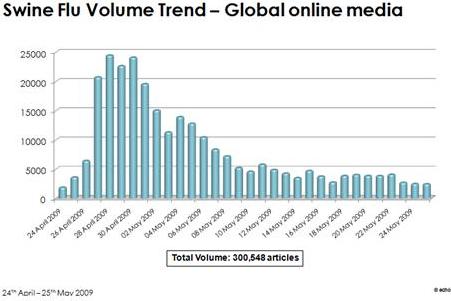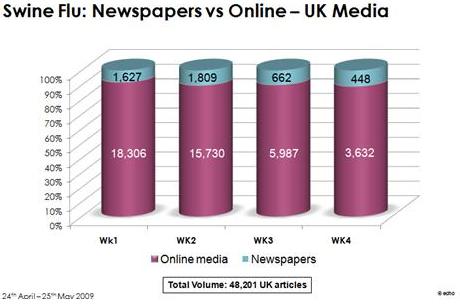Research commissioned by PRmoment underlines how the considerable media interest in swine flu in late April, when the first two cases were confirmed in Scotland, then dropped dramatically, despite confirmed cases in the UK increasing to 185 earlier this week (according to the BBC n), more than any other country in Europe.
Swine flu created a media frenzy a month ago, but as cases increase, interest wanes.

Supplied by Echo Sonar
Although there is still media interest in swine flu, such as on 28 May when there was widespread reporting of Eton school closing due to a boy testing positive for swine flu, the frenzy seems have had a lull in the last few weeks. From 27 April to 30 April, the research shows that over 20,000 articles a day appeared in global online media, whereas earlier this week the average daily number of articles is less than 3,000. When the news first started going wild for this story, there were just 40 confirmed cases of swine flu in the US according to the BBC on 27 April, compared to 6,764 (and 10 deaths) on 27 May. Before swine flu hit the news, bird flu was still a newsworthy story, but with no cases of humans catching this virus in the UK, it must have been a relief for journalists looking for health-scare news to find a virus that might actually infect one of their readers. The scale of the news coverage has led some to believe that businesses, such as pharmaceutical firms, are encouraging scare mongering for a reason. Sally Durcan, director at marketing agency Hotcow, describes swine flu as “the biggest marketing scam ever” and a tactic to keep people afraid and buying more drugs. She adds: “Why else do every year we see the papers filled with flu epidemics and what the vaccine is to ensure you don't get it? The drug companies have to go to these lengths because people just aren't listening any more. We are inundated with thousands of messages a day and everyone wants you to buy their product. For example, if you have always purchased the red pill at the pharmacy for your pain and it has worked you will consistently buy the red pill, not the blue pill. The blue pill marketing team will need to look for new ways to get people to start listening - and scare tactics are a good place to start.”

Supplied by Echo Sonar
However, Martin Godfrey, client services director at PR firm Hill & Knowlton disagrees that the media has inflated the importance of this flu. He says: “Generally I think it has been handled in a balanced way.” He points out that previous flu pandemics, notably the one of 1918 that killed more than 20 million people worldwide, shows that swine flu should be taken seriously. Godfrey adds: “It is always possible to scare people, yet the press has managed not to do this, while publicising the risk and listening to what the Department of Health is saying.” According the Godfrey, a future concern is that bird flu and swine flu viruses may mutate together, creating a new super virus, which means it is too soon to relax about the chances of a future pandemic. This is why the press has to keep track of developments in swine flu and bird flu, even though the present swine flu virus has shown itself not to be lethal in the UK.
One reason that swine flu generated such immense interest in the media is because there are so many healthcare journalists. Godfrey points out that the media’s interest in healthcare journalism began when HIV/Aids became an issue in the 1980s. After this, there was a substantial increase in the number of health writers with more newspapers introducing dedicated health correspondents. This has led to an “insatiable” desire for health news stories. It is also no surprise that online media are quick to pick up on health stories, when, according to Godfrey, health is arguably the number one subject that people are interested in when surfing the internet.
This is backed up by the significant finding of the research that shows how much more swine flu news is available online in the UK compared to newspapers. Throughout the research period, over 70 per cent of articles appeared online. For example, in the last week there were nearly 450 newspaper articles on swine flu compared with over 3,600 online. This reflects the huge growth in online news coverage. PRmoment will be further analysing how consumers like to access news today in our next PRreview feature.
PRmoment asked Echo Sonar to analyse global media coverage of Swine flu from 24 April to 25 May 2009. Media was analysed in Asia Pacific, Central and South America, Europe, the Middle East and Africa and North America. The metrics included daily trends, and regional share of voice of UK newspapers against online weekly coverage.
PR Masterclass: The Intersection of PR and GEO
Join PRmoment for a Masterclass featuring 10 of the industry’s foremost experts. You will walk away with a clear, actionable strategy for adapting your content to an AI-first search environment.
Taking place on Wednesday 25th February in London, both virtual and in person tickets are available.
If you enjoyed this article, sign up for free to our twice weekly editorial alert.
We have six email alerts in total - covering ESG, internal comms, PR jobs and events. Enter your email address below to find out more:









